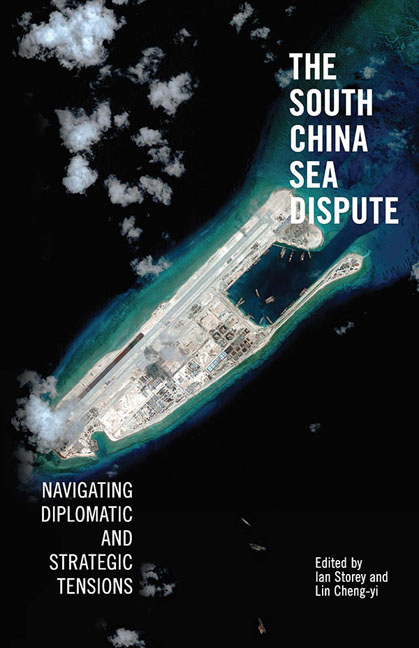Book contents
- Frontmatter
- Contents
- About the Contributors
- 1 Introduction
- 2 Untangling a Complex Web: Understanding Competing Maritime Claims in the South China Sea
- 3 China Debates the South China Sea Dispute
- 4 Taiwan's Evolving Policy towards the South China Sea Dispute, 1992–2016
- 5 The South China Sea: Primary Contradictions in China–Southeast Asia Relations
- 6 Rising Tensions in the South China Sea: Southeast Asian Responses
- 7 The Philippines and the South China Sea Dispute: Security Interests and Perspectives
- 8 A Vietnamese Perspective on the South China Sea Dispute
- 9 The South China Sea Dispute: Options for Malaysia
- 10 The United States and the South China Sea: Front Line of 228 Hegemonic Tension?
- 11 The South China Sea Dispute in U.S.–ASEAN Relations
- 12 Japan and the South China Sea Dispute: A Stakeholder's Perspective
- 13 Conclusion
- Index
2 - Untangling a Complex Web: Understanding Competing Maritime Claims in the South China Sea
Published online by Cambridge University Press: 19 May 2017
- Frontmatter
- Contents
- About the Contributors
- 1 Introduction
- 2 Untangling a Complex Web: Understanding Competing Maritime Claims in the South China Sea
- 3 China Debates the South China Sea Dispute
- 4 Taiwan's Evolving Policy towards the South China Sea Dispute, 1992–2016
- 5 The South China Sea: Primary Contradictions in China–Southeast Asia Relations
- 6 Rising Tensions in the South China Sea: Southeast Asian Responses
- 7 The Philippines and the South China Sea Dispute: Security Interests and Perspectives
- 8 A Vietnamese Perspective on the South China Sea Dispute
- 9 The South China Sea Dispute: Options for Malaysia
- 10 The United States and the South China Sea: Front Line of 228 Hegemonic Tension?
- 11 The South China Sea Dispute in U.S.–ASEAN Relations
- 12 Japan and the South China Sea Dispute: A Stakeholder's Perspective
- 13 Conclusion
- Index
Summary
This chapter outlines and analyses the competing claims to maritime jurisdiction made in the South China Sea. As the title suggests, this is not a straightforward task. Indeed, the South China Sea is perhaps the world's most contested maritime space, characterized by complex coastal geography, numerous sovereignty disputes over islands featuring multiple claimants, excessive and controversial claims to baselines, conflicting and overlapping maritime claims to and controversial submissions regarding extended continental shelf rights.
The chapter begins with an overview of the geographical setting of the South China Sea before moving on to address the competing claims to maritime space that exist within the Sea. The latter section covers issues related to baselines as well as broad unilateral and supposedly historic-based maritime claims. Existing maritime boundary delimitation agreements and joint maritime arrangements are reviewed before the implications of fresh developments — particularly the extended continental shelf submissions and the reactions they provoked — are examined with a view to untangling and at least partially clarifying a most complex web of conflicting maritime claims.
GEOGRAPHICAL CONTEXT
The South China Sea (together with the Gulf of Thailand) represents an extensive semi-enclosed sea located between the southern coasts of China and Taiwan to the north, the mainland coasts of Southeast Asia to the west, and the archipelagic island groups of the Philippines, Borneo and Indonesia to the east and south. It encompasses an area of approximately three million square kilometres (equivalent to around 874,660 square nautical miles (nm)).
In total, ten states (or entities) border the South China Sea: Brunei, Cambodia, China, Indonesia, Malaysia, the Philippines, Singapore, Taiwan, Thailand and Vietnam. Among these coastal states, six can be regarded as claimants in the sense that they claim sovereignty over all or some of the disputed islands and related insular features together with their associated maritime spaces. These are: Brunei, China, Malaysia, the Philippines, Taiwan and Vietnam. This is not, however, to suggest that the other littoral states do not advance maritime jurisdictional claims in the South China Sea — some of which, indeed, overlap with those made by neighbouring coastal states — just that territorial sovereignty over the disputed South China Sea islands is not an issue.
- Type
- Chapter
- Information
- The South China Sea DisputeNavigating Diplomatic and Strategic Tensions, pp. 21 - 46Publisher: ISEAS–Yusof Ishak InstitutePrint publication year: 2016



